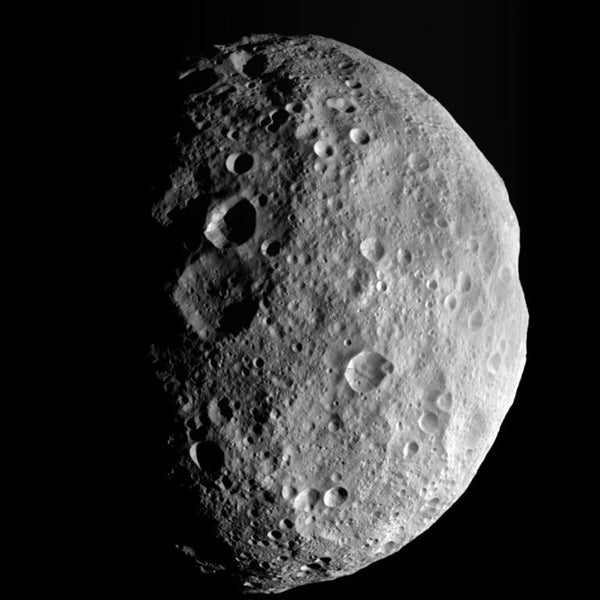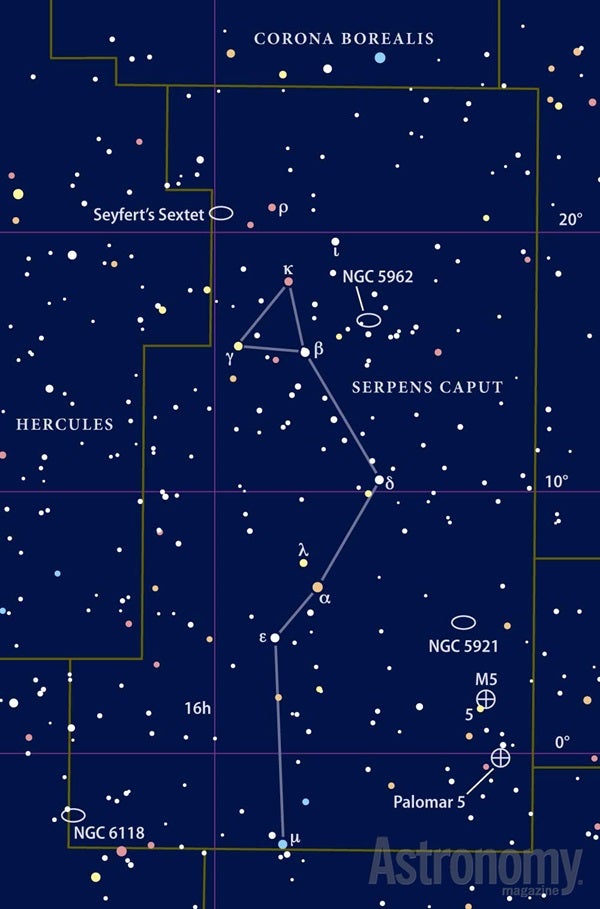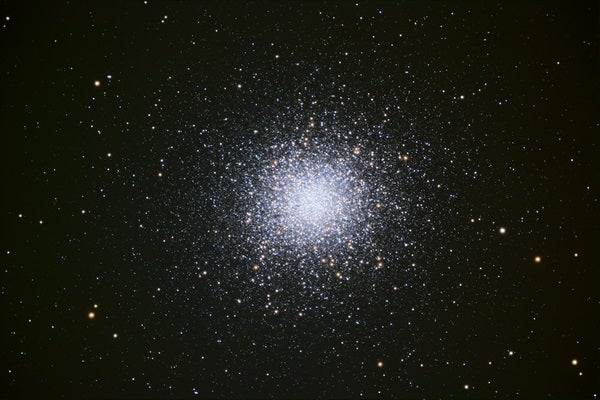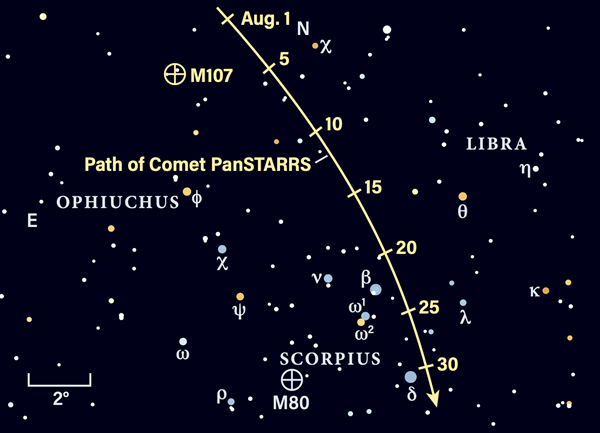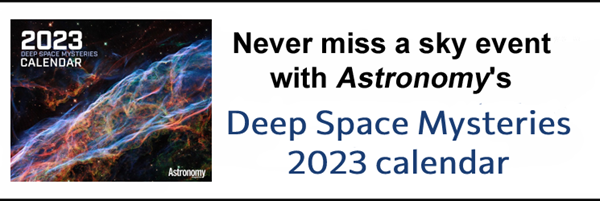Friday, August 19
Last Quarter Moon occurs at 12:36 A.M. EDT; later this morning, the Moon will pass 3° due north of Mars at 8 A.M. EDT.
With no Moon in the evening sky this week, it’s going to be a great time for some deep-sky observing after dark. Lyra the Lyre is high overhead after sunset, and home to two Messier objects: the globular cluster M56 and the famous Ring Nebula (M57).
The Ring Nebula is a planetary nebula, created by the puffed-off outer layers of a Sun-like star as it enters the later stages of its life. At 9th magnitude, it’s a great target for small or medium scopes and considered by many a showpiece of the summer sky in the Northern Hemisphere. You’ll find it roughly halfway between Gamma (γ) and Beta (β) Lyrae. The best way to search for it is to slowly sweep this area with a low-power eyepiece, looking for a grayish or greenish oval-shaped glow. Averted vision may really serve you here. When you do find it, switch to a higher-power eyepiece to take in greater detail — note that most observers agree you’ll need a 6-inch scope or larger to really make out the “ring” of brighter emission at the edges that gives this nebula its name.
Sunrise: 6:15 A.M.
Sunset: 7:51 P.M.
Moonrise: —
Moonset: 2:33 P.M.
Moon Phase: Waning crescent (45%)
*Times for sunrise, sunset, moonrise, and moonset are given in local time from 40° N 90° W. The Moon’s illumination is given at 12 P.M. local time from the same location.
Saturday, August 20
After passing Mars yesterday, the Moon is still in Taurus this morning before sunrise, now some 12° east of the Red Planet. Together with the Pleiades, they form a triangle on the sky pointing east along the ecliptic, toward Venus (magnitude –3.9 in Cancer) and ultimately the Sun.
At magnitude 0, Mars is just slightly brighter than nearby Aldebaran, the magnitude 0.9 reddish eye of Taurus the Bull. The Red Planet sits 11° (or slightly more than the distance spanned by your fist held out at arm’s length) above Aldebaran; compare their brightness and color for yourself. For further comparison, look another 21.5° (or two fists stacked on top of each other) below Aldebaran. That’s Betelgeuse, a slightly brighter magnitude 0.5 red giant, whose ruddy color should also be apparent. The three form a roughly straight line on the sky and will continue to do so for a few more days, as Mars tracks slowly east, drawing closer to Aldebaran.
Sunrise: 6:16 A.M.
Sunset: 7:50 P.M.
Moonrise: 12:07 A.M.
Moonset: 3:34 P.M.
Moon Phase: Waning crescent (36%)
Sunday, August 21
The constellation Serpens is the only such star pattern that is broken into two distinct pieces: Serpens Cauda (the Serpent’s Tail) and Serpens Caput (the Serpent’s Head). The reason for this strange setup is that Ophiuchus the Serpent-bearer is carrying this celestial snake through the sky, and his territory breaks up the area dedicated to his load.
Tonight, we’ll concentrate on the front portion of the snake: Serpens Caput. It’s located in the southwestern sky after sunset and fortunately isn’t hard to find. Most observers use two bright red giant stars — Antares in Scorpius and Arcturus in Boötes — to guide them in their hunt. Once you’ve found these two stars, draw an imaginary line between them and look about halfway along it. Then tilt your gaze just north of that point, and you’re in Serpens Caput.
Magnitude 2.6 Unukalhai is this constellation’s brightest star, which lies in roughly the center of this constellation. Some 15 times as wide as our Sun, this star is no longer in the hydrogen-burning phase of its life, but has begun fusing heavier elements like carbon and oxygen instead. About 10° to this star’s north is a triangle of three stars that you can likely visualize as a snake’s head, outlined by Beta, Gamma, and Kappa (κ) Serpentis.
Sunrise: 6:17 A.M.
Sunset: 7:48 P.M.
Moonrise: 12:45 A.M.
Moonset: 4:32 P.M.
Moon Phase: Waning crescent (27%)
Monday, August 22
Asteroid 4 Vesta reaches opposition at 3 P.M. EDT. This large, bright, main-belt world is visible all night in Aquarius, floating near another famous planetary nebula: NGC 7293, also called the Helix Nebula. For the best viewing, wait at least two hours after sunset for the sky to get nice and dark and for the region housing Vesta and the Helix nebula to climb out of the haze near the horizon in the southeastern sky.
First, let’s find Vesta. At magnitude 5.8, it’s just at the edge of naked-eye visibility from a good, dark observing site. Otherwise, binoculars or any small scope will certainly capture it. Our quarry sits 9.5° west-southwest of magnitude 3.3 Skat in Aquarius. Alternatively, you can drop 8.5° southeast of magnitude 2.9 Deneb Algedi in Capricornus, or 11.5° southeast of Saturn, which tonight shines at magnitude 0.3.
Now, let’s try something harder: the Helix. Astronomy contributing editor Michael E. Bakich has called this planetary nebula “one of the brightest hard-to-see objects in the sky.” That’s because despite its magnitude of 7.3, the Helix stretches 13′ across, smearing that light out across a large area and rendering its surface brightness low. Bakich says you can find it in binoculars with lenses larger than 50 millimeters that give 7x to 15x magnification. However, he recommends at least a 4-inch scope or larger for a brighter, more detailed view. Stick to low magnifications to see the whole nebula or bump up the power to examine just a portion of it.
Tonight, the Helix sits just 2.5° east-southeast of Vesta. If you need a brighter signpost, look 7.8° southwest of Skat or 1.2° due west of 5th-magnitude Upsilon (υ) Aquarii.
Sunrise: 6:18 A.M.
Sunset: 7:47 P.M.
Moonrise: 1:31 A.M.
Moonset: 5:24 P.M.
Moon Phase: Waning crescent (19%)
Tuesday, August 23
As summer fades to fall, we’re slowly losing the chance to view one of the best globular clusters in the northern sky: M13 in Hercules. Fortunately, there’s still plenty of time, as the Strongman remains more than 75° high in the western sky an hour after sunset tonight.
M13, also called the Hercules Cluster or the Great Globular Cluster in Hercules, certainly lives up to its name. Just visible to the naked eye under dark-sky conditions at magnitude 5.8, this dense ball of stars spans just 20′ and crams several hundred thousand stars (at least) into a volume less than 150 light-years in diameter.
M13 lies just less than 2.5° south of magnitude 3.5 Eta (η) Herculis. You can resolve it easily with a 3-inch scope, so you don’t need a big instrument to dig into its details. At magnifications of 200x or greater, look also for its strange “propeller” feature: a Y-shaped region of dark lanes near the cluster’s center.
Sunrise: 6:19 A.M.
Sunset: 7:45 P.M.
Moonrise: 2:22 A.M.
Moonset: 6:10 P.M.
Moon Phase: Waning crescent (12%)
Wednesday, August 24
Uranus is stationary against the background stars of Aries at 11 A.M. EDT. It’s been traveling slowly east along the ecliptic, but now it will turn around and track back the other way in the coming days.
You’ll find the planet high in the southeast, some 65° above the horizon an hour before dawn. There aren’t many bright stars in this area, but you can use magnitude 4.3 Mu (μ) Ceti: Uranus is roughly 8.5° northeast of this star.
Observers will need at least binoculars to spot the magnitude 5.8 ice giant, which shows off a 4″-wide disk if you bump your observing apparatus up to a telescope. Does that disk look subtly bluish to you? Compare it with ruddy Mars, 13° to its east. Their color difference should be quite readily apparently.
Sunrise: 6:20 A.M.
Sunset: 7:44 P.M.
Moonrise: 3:20 A.M.
Moonset: 6:49 P.M.
Moon Phase: Waning crescent (7%)
Thursday, August 25
A delicate crescent Moon (just 4 percent lit) sits in eastern Cancer the Crab this morning. Dwarf planet 1 Ceres is some 3.3° to its east, a dim magnitude 8.6. Ceres is the largest body in the main belt — so massive that it is round and classified as the closest dwarf planet to Earth. It’s currently some 3.5 astronomical units (AU; 1 AU is the average Earth-Sun distance) from Earth, or 325 million miles (523 million kilometers) away. Later today, at 3 P.M. EDT, the Moon will pass 0.7° south of Ceres.
Just 3° above the eastern horizon an hour before sunrise is brilliant Venus, impossible to miss at magnitude –3.9. Turn a telescope on Earth’s sister world and you’ll see that its disk stretches 10″ wide and is 96 percent lit. Venus’ altitude is dropping day by day as its elongation from the Sun declines, reaching 14° by the end of the month. Thankfully, the planet is so bright that it will remain relatively easy to spot in the growing twilight each morning.
Continuing along the ecliptic, the Moon will pass 4° north of Venus at 5 P.M. EDT.
Sunrise: 6:21 A.M.
Sunset: 7:42 P.M.
Moonrise: 4:21 A.M.
Moonset: 7:22 P.M.
Moon Phase: Waning crescent (3%)
Friday, August 26
Currently around magnitude 9, Comet C/2017 K2 (PanSTARRS) lies nearly between two 2nd-magnitude stars in Scorpius: Arcab and Dschubba. Tonight, the comet is located just northwest of a line drawn between these two luminaries, with plenty of deep-sky treats nearby to enjoy as well. The closest is M80, a 7th-magnitude globular cluster that spans a compact 10′. You’ll find this cluster just less than 4.5° southeast of the comet, on the other side of the Arcab-Dschubba line.
Compare and contrast the appearance of these two objects. Many observers say that M80 itself looks like a fuzzy comet nucleus without a tail, though its light may appear on the slightly warmer side, thanks to plentiful aging stars, whose glow grows redder over time. Plus, because PanSTARRS is currently 2.5 AU from the Sun, the mechanism that turns many comet nuclei green isn’t active, so its coma appears white. That green glow occurs when dicarbon molecules are excited by sunlight.
Sunrise: 6:22 A.M.
Sunset: 7:41 P.M.
Moonrise: 5:24 A.M.
Moonset: 7:50 P.M.
Moon Phase: Waning crescent (1%)

